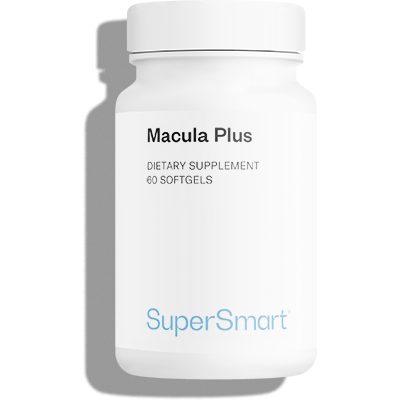Improving eye protection
 The eye health benefits of lutein, zeaxanthinand mesozeaxanthin have been known for many years. By protecting tissues in the retina and lens, they help prevent cataracts and age-related macular degeneration..
The eye health benefits of lutein, zeaxanthinand mesozeaxanthin have been known for many years. By protecting tissues in the retina and lens, they help prevent cataracts and age-related macular degeneration..
Now researchers have discovered that flavonoids such as cyanidin-3-glycoside (C3G), found in berries and black rice, improve eyesight and boost night vision. They benefit the molecular processes that accelerate restoration of rhodopsin, the pigment present in the eye's photoreceptor cells. Rhodopsin is responsible for the eye's sensitivity to light and is thus essential for good night vision.
Astaxanthin relieves tired eyes and provides additional protection both against inflammatory changes that aggravate macular degeneration as well as the harmful effects of high ocular pressure..
Cyanidin-3-glycoside improve night vision
Rhodopsin, or visual purple, is a photosensitive pigment present in the retina's photoreceptor cells (cones and rods). It is responsible for sensitivity to light and night vision. As we age, the ability of rhodopsin to regenerate diminishes, eventually leading to a progressive loss of night vision.
Under normal conditions, we perceive light when particles called photons cross the eye's lens, and hit the retina. The eye is designed to receive and convert light into images across the cones and rods. Cones perceive light while rods are very sensitive to darkness. Rhodopsin is essentially used by rods.
hodopsin consists of a protein called opsin, to which retinene or retinal (an aldehyde of vitamin A) is bound. The process of vision starts with a molecule of rhodopsin receiving a photon of energy. The rhodopsin causes the two molecules from which it is formed to split, releasing a reaction which sends a signal to the centre of the brain to produce images in the dark. The retinal and opsin then combine to reform rhodopsin.
While the split between retinal and opsin happens almost instantaneously, it can take some time before they recombine to form rhodopsin and restore it to optimal levels, during which night vision is compromised. Ageing is directly associated with a decrease in ability to regenerate rhodopsin.
Cyanidin-3-glycoside (C3G) is a purple pigment and one of the family of flavonoids. Like most flavonoids, tt is alsoa powerful antioxidant whichoffers considerable protection in the high energy environment of the retina where free radicals are a constant threat.
Japanese researchers have discovered that C3G stimulates the regeneration of rhodopsin in animal retinal cells 1. Other studies have shown that C3G binds directly to rhodopsin, creating a change in its molecular structure which accelerates its regeneration 2. One study of healthy volunteers suggests that C3G produced an improvement in the night vision of older people just 30 minutes after taking it. 3.
C3G has a number of benefits, due largely to its antioxidant properties, including - alongside other nutrients - protection for the eyes against radical attack.
Lutein, zeaxanthin and mesozeaxanthin protect the retina These three xanthophyll carotenoids make up the macular pigment - a protective layer which absorbs blue light and UV rays.
Blue light has extremely high energy which can cause photooxidative damage and lipid peroxidation harmful to the retina and lens. Once the macula and photoreceptor cells become damaged, age-related macular degeneration (AMD) can develop; when the lens is damaged, the consequence can be cataracts.
Lutein and zeaxanthin are present in photoreceptor cells in the outer segments of the rods responsible for detecting light radiation. These two carotenoids provide effectiveand much-needed protection as the rods' outer membrane is rich in polyunsaturated fatty acids and thus particularly vulnerable to free radical attack.
Lutein, zeaxanthin and mesozeaxanthin are also potent antioxidants which can neutralise the destructive free radicals generated when light energy reacts with delicate eye tissues. A healthy macular pigment of adequate density can neutralise photo-oxidation by filtering blue light, and reduce glare and chromatic aberration as well as improve contrast and visual acuity.
However, macular pigment density diminishes with age. Studies show that supplementing with lutein, zeaxanthin and mesozeaxanthin boosts macular pigment density providing protection against AMD. 4.  Cataracts are another major cause of blindness. Oxidation of lens proteins plays a crucial role in the development of this disease. Studies show that lutein and zeaxanthin protect cells in the lens against UV damage, an important factor in the development of cataracts. Such research suggests that lutein and zeaxanthin provide this protection by preventing sunlight-induced oxidative stress in the eye. 5.
Cataracts are another major cause of blindness. Oxidation of lens proteins plays a crucial role in the development of this disease. Studies show that lutein and zeaxanthin protect cells in the lens against UV damage, an important factor in the development of cataracts. Such research suggests that lutein and zeaxanthin provide this protection by preventing sunlight-induced oxidative stress in the eye. 5.
Acting as a kind of solar filter, lutein and zeaxanthin improve the eyes' reactions to glare 6.
Astaxanthin helps relieve tired eyes
Even in ideal ergonomic conditions with optimal light and visual correction, a week in front of a computer takes its toll on the eye muscles which become tired and weak over time.

Working at a computer screen means the eyes are constantly bombarded with bright light and visual stimulation atclose range. This leads to an increase in accommodation duration which in turn results in ocular fatigue or eye strain.
Eye strain, or asthenopia, is characterised in particular by ocular weakness, eye irritation and difficulties with accommodation - the time it takes to re-focus between close range and distance work.
Sensitivity to glare can also increase and perception of depth may be compromised. Other symptoms may appear and get worse as the day goes on, especially in people spending between four and seven hours without a a break in front of a computer.
Astaxanthin is a carotenoid found in algae and the tissues of salmon, trout, shrimps and other fish and seafood - indeed it is what gives them their pink colour. Studies suggest that supplementing with astaxanthin can in part prevent duration of accommodation, thus helping to reduce ocular fatigue. Astaxanthin also improves blood flow in the retina 7.
Astaxanthin is highly fat-soluble, which gives it a strong affinity with the lipid-rich cell membranes vital to eye health and overall cell function. In addition, alongside lutein and zexanthin, its powerful antioxidant properties help to protect lens tissues against damaging free radicals.
Inflammatory changes also contribute to long term retinal damage, due largelyto their effect on the tiny blood vessels in the eyes. Astaxanthin reduces inflammation in the eyes by:
suppressing nitric oxide synthase pro-inflammatory signals, prostaglandin E2 and TNF-alpha 8,
regulating downwards the nuclear factor K-b signalling pathways which govern cell response to inflammation 9,
, protecting DNA from damage by reactive oxygen species10.  The anti-inflammatory effects of astaxanthin also protect retinal tissues against wet' or exudative AMD,by reducing the formation of new blood vessels observed in the later stages of the disease. Last but not least, astaxanthin combats retinal cell destruction due to the increased intra-ocular pressure characteristic of glaucoma - another cause of blindness in the elderly.
The anti-inflammatory effects of astaxanthin also protect retinal tissues against wet' or exudative AMD,by reducing the formation of new blood vessels observed in the later stages of the disease. Last but not least, astaxanthin combats retinal cell destruction due to the increased intra-ocular pressure characteristic of glaucoma - another cause of blindness in the elderly.
References :
1. Matsumoto H. et al., Stimutalory effect of cyanidin-3-glycosides on the regeneration of rhodopsin. J. Agric. Food. Chem. 2003 Jun. 4 ; 51(12) : 3560-3.
2. Tirupula K. C. et al., pH-dependent interaction of rhodopsin with cyanidin-3-glucoside. Structural aspects. Photochem. Photobiol. 2009 Mar.-Apr. ;85(2) : 463-70.
3. Nakaishi H. et al., Effects of black current anthocyanoside intake on dark adaptation and VDRT work-induced transient refractive alteration in healthy humans, Alt. Med. Rev. 2000 Dec. ; 5(6) : 553-62.
4. SanGiovanni J. P. et al., The relationship of dietary carotenoid and vitamin A, E et C intake with age-related macular degeneration in a case-control study, AREDS report n° 22, Arch. Ophtalm., 2007 Sept., 125(9):1225-32.
5. Chitchumroonchokchai C. et al., Xantophylls and alpha-tocopherol decrease UVB-induced lipid peroxidation and stress signaling in human lens epithelial cells, J. Nutr., 2004 Dec., 134(12):3225-32.
6. Stringham J. M. et al., Macular pigment and visual performance under glare conditions, Optom. Vis. Sci., 2008 Feb., 85(2):82-8.
7. Takahashi Nanako et al., Effects of astaxanthin on accommodative recovery, Journal of Clinical Therapeutics & Medicines, 2005, 21(4):431-436.
8. Ohgami K. et al., Effects of astaxanthin on lipopolysaccharide-induced inflammation in vitro and in vivo. Invest. Ophtalmol. Vis. Sci. 2003 Jun. ; 44(6):2694-701.
9. Suzuki Y. et al., Suppressive effects of astaxanthin against rat endotoxin-induced uveitis by inhibiting the NF-kappa B signaling pathway. Exp. Eye Res. 2006 Feb. ;82(2):275-81.
10. Santocono M. et al., Lutein, zeaxanthin and astaxanthin protect against DNA damage in SK-N-SH human neuroblastoma cells induced by reactive nitrogen species. J. Photochem. Photobiol. B 2007 Jul. 27 ; 88(1):1-10.

Improved formulation
Boosts visual and macular protection
Maximal bioavailability and stability
All rights reserved
Free
Thank you for visiting our site. Before you go
REGISTER WITHClub SuperSmart
of exclusive benefits:
- Free: our weekly science-based newsletter "Nutranews"
- Special offers for club members only

















